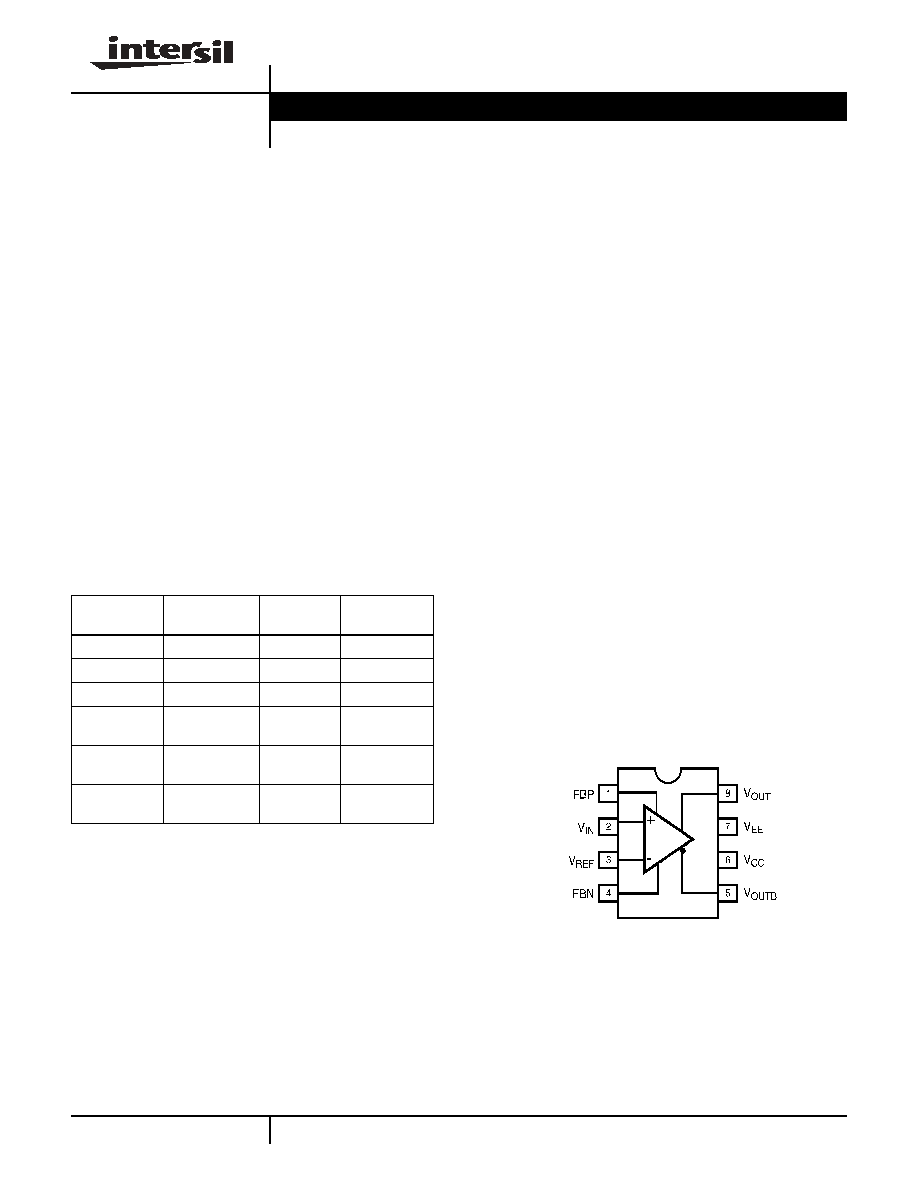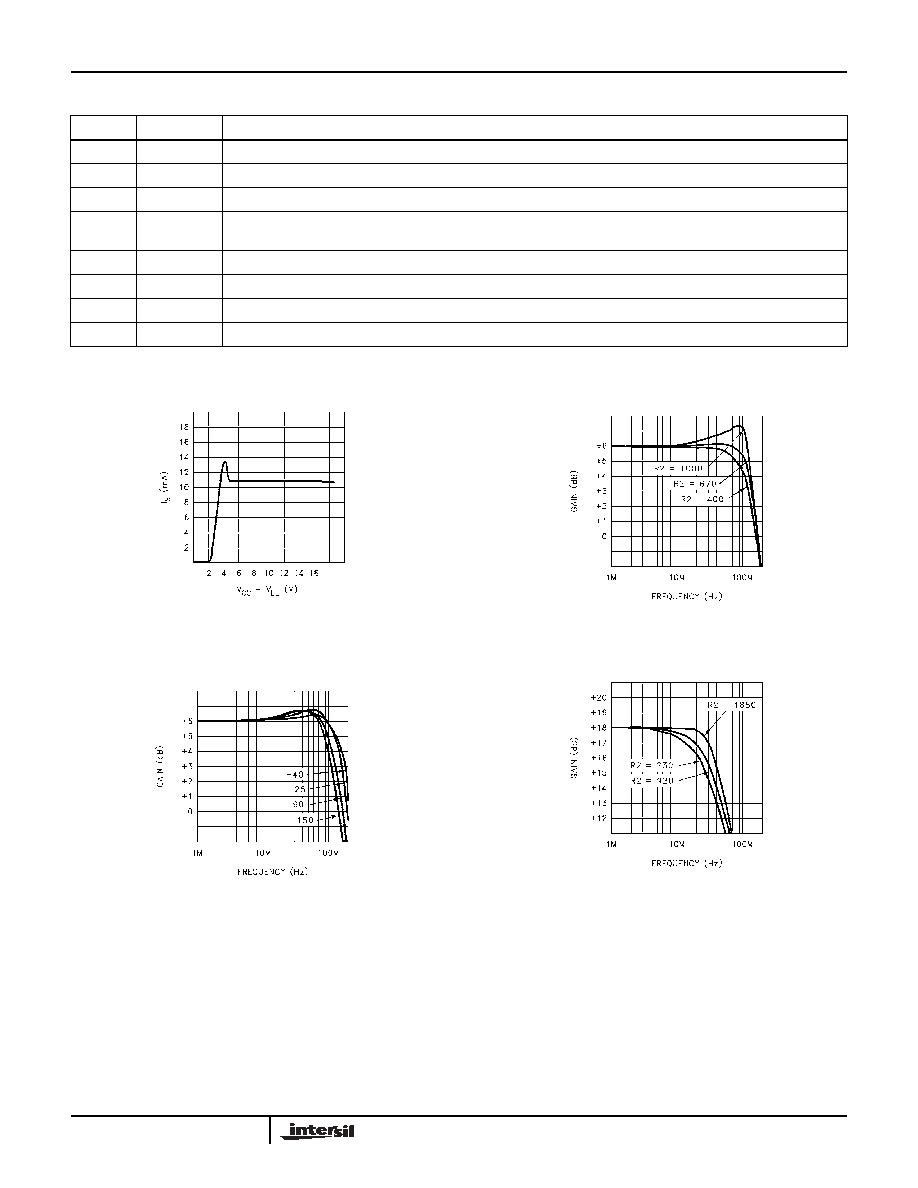
1
Æ
FN7048.1
EL2141
150MHz Differential Twisted Pair Driver
The EL2141 is a very high bandwidth amplifier whose output
is in differential form, and is thus primarily targeted for appli-
cations such as driving twisted pair lines, or any application
where common mode injection is likely to occur. The input
signal can be in either single-ended or differential form, but
the output is always in differential form.
On the EL2141, two feedback inputs provide the user with
the ability to set the device gain, (stable at minimum gain of
two).
The output common mode level is set by the reference pin
(V
REF
), which has a -3dB bandwidth of over 100MHz. Gen-
erally, this pin is grounded, but it can be tied to any voltage
reference.
The transmission of ADSL/HDSL signals requires very low
distortion amplification, so this amplifier was designed with
this as a primary goal. The actual signal distortion levels
depend upon input and output signal amplitude, as well as
the output load impedance. (See distortion data inside.)
Both outputs (V
OUT
, V
OUTB
) are short circuit protected to
withstand temporary overload condition.
Features
∑ Fully differential inputs, outputs, and feedback
∑ Differential input range ±2.3V
∑ 150MHz 3dB bandwidth
∑ 800V/
µ
s slew rate
∑ -55dB distortion at 3MHz
∑ -75dB distortion at 100kHz
∑ ±5V supplies or +6V single supply
∑ 50mA minimum output current
∑ Output swing (200
load) to within 1.5V of supplies
(14V
PKPK
differential)
∑ Low power-11mA typical supply current
∑ Pb-free available (RoHS compliant)
Applications
∑ Twisted pair driver
∑ Differential line driver
∑ VGA over twisted pair
∑ ADSL/HDSL driver
∑ Single ended to differential amplification
∑ Transmission of analog signals in a noisy environment
Pinout
EL2141
(8-PIN SOIC)
TOP VIEW
Ordering Information
PART
NUMBER
PACKAGE
TAPE &
REEL
PKG. DWG. #
EL2141CS
8-pin SOIC
-
MDP0027
EL2141CS-T7
8-pin SOIC
7"
MDP0027
EL2141CS-T13
8-pin SOIC
13"
MDP0027
EL2141CSZ
(See Note)
8-pin SOIC
(Pb-free)
-
MDP0027
EL2141CSZ-T7
(See Note)
8-pin SOIC
(Pb-free)
7"
MDP0027
EL2141CSZ-
T13 (See Note)
8-pin SOIC
(Pb-free)
13"
MDP0027
NOTE: Intersil Pb-free products employ special Pb-free material sets;
molding compounds/die attach materials and 100% matte tin plate
termination finish, which are RoHS compliant and compatible with
both SnPb and Pb-free soldering operations. Intersil Pb-free products
are MSL classified at Pb-free peak reflow temperatures that meet or
exceed the Pb-free requirements of IPC/JEDEC J STD-020.
Data Sheet
February 11, 2005
CAUTION: These devices are sensitive to electrostatic discharge; follow proper IC Handling Procedures.
1-888-INTERSIL or 1-888-352-6832
|
Intersil (and design) is a registered trademark of Intersil Americas Inc.
Copyright Intersil Americas Inc. 1995, 2005. All Rights Reserved
All other trademarks mentioned are the property of their respective owners.

2
FN7048.1
February 11, 2005
Absolute Maximum Ratings
(T
A
= 25∞C)
Supply Voltage V
S
+
and GND . . . . . . . . . . . . . . . . . . . . . . . . +12.6V
Maximum Output Current. . . . . . . . . . . . . . . . . . . . . . . . . . . . ±60mA
Storage Temperature Range . . . . . . . . . . . . . . . . . .-65∞C to +150∞C
Operating Junction Temperature . . . . . . . . . . . . . . . . . . . . . . +150∞C
Recommended Operating Temperature . . . . . . . . . . . -40∞C to 85∞C
V
IN
, V
INB
, V
REF
. . . . . . . . . . . . V
EE
+0.8V (MIN) to V
CC
-0.8V (MAX)
V
IN
≠V
INB
. . . . . . . . . . . . . . . . . . . . . . . . . . . . . . . . . . . . . . . . . . .±5V
CAUTION: Stresses above those listed in "Absolute Maximum Ratings" may cause permanent damage to the device. This is a stress only rating and operation of the
device at these or any other conditions above those indicated in the operational sections of this specification is not implied.
IMPORTANT NOTE: All parameters having Min/Max specifications are guaranteed. Typical values are for information purposes only. Unless otherwise noted, all tests
are at the specified temperature and are pulsed tests, therefore: T
J
= T
C
= T
A
DC Electrical Specifications
V
CC
= +5V, V
EE
= -5V, T
A
= 25∞C, V
IN
= 0V, R
L
= 200, unless otherwise specified.
PARAMETER
DESCRIPTION
MIN
TYP
MAX
UNITS
V
SUPPLY
Supply Operating Range (V
CC
≠V
EE
)
±3.0
±5.0
±6.3
V
I
S
Power Supply Current (No Load)
11
14
mA
V
OS
Input Referred Offset Voltage
-25
10
40
mV
I
IN
Input Bias Current (V
IN
, V
INB
, V
REF
)
-20
6
20
µ
A
Z
IN
Differential Input Impedance
400
k
V
DIFF
Differential Input Range
±2.0
±2.3
V
A
VOL
Open Loop Voltage Gain
75
dB
V
OUT
(200)
Output Voltage Swing (200
load, V
OUT
to V
OUTB
)
±3.4
±3.6
V
V
OUT
(100)
Output Voltage Swing (100
Load, V
OUT
to V
OUTB
)
±2.9
±3.1
V
V
N
Input Referred Voltage Noise
36
nV/
Hz
V
REFOS
Output Offset Relative to V
REF
-60
-25
+60
mV
PSRR
Power Supply Rejection Ratio
60
70
dB
I
OUT
(min)
Minimum Output Current
50
60
mA
R
OUT
(V
OUT
= V
OUTB
= 0V) Output Impedance
0.1
AC Electrical Specifications
V
CC
= +5V, V
EE
= -5V, T
A
= 25∞C, V
IN
= 0V, R
LOAD
= 200, unless otherwise specified
PARAMETER
DESCRIPTION
MIN
TYP
MAX
UNITS
BW(-3dB)
-3dB Bandwidth (@ gain of 2)
150
MHz
SR
Differential Slewrate
800
V/
µ
s
Tstl
Settling Time to 1%
15
ns
GBW
Gain Bandwidth Product
400
MHz
V
REFBW
(-3dB)
V
REF
-3dB Bandwidth
130
MHz
V
REFSR
V
REF
Slewrate
100
V/
µ
s
THDf1
Distortion at 100kHz (Note 1)
-75
dB
dP
Differential Phase @ 3.58MHz
0.16
∞
dG
Differential Gain @ 3.58MHz
0.24
%
NOTE:
1. Distortion measurement quoted for V
OUT
≠V
OUTB
= 12V pk-pk, R
LOAD
= 200
, V
GAIN
= 8
EL2141

3
FN7048.1
February 11, 2005
Pin Descriptions
EL2141
PIN NAME
FUNCTION
2
V
IN
Non-inverting Input
1
FBP
Non-inverting Feedback Input. Resistor R1 must be Connected from this Pin to V
OUT
.
4
FBN
Inverting Feedback Input. Resistor R3 must be Connected from this pin to V
OUTB
.
3
V
REF
Output Common-mode Control. The Common-mode Voltage of V
OUT
and V
OUTB
will Follow the Voltage on this Pin.
Note that on the EL2141, this pin is also the V
INB
pin.
5
V
OUTB
Inverting Output
6
V
CC
Positive Supply
7
V
EE
Negative Supply
8
V
OUT
Non-inverting Output
Typical Performance Curves
FIGURE 1. I
S
vs SUPPLY VOLTAGE
FIGURE 2. FREQUENCY RESPONSE vs RESISTOR R2
(GAIN = 2)
FIGURE 3. FREQUENCY RESPONSE vs TEMPERATURE
FIGURE 4. FREQUENCY RESPONSE vs RESISTOR R2
(GAIN = 8)
EL2141

4
FN7048.1
February 11, 2005
Applications Information
Choice of Feedback Resistor
There is little to be gained from choosing resistor R2 values
below 400
and, in fact, it would only result in increased
power dissipation and signal distortion. Above 400
, the
bandwidth response will develop some peaking (for a gain of
two), but substantially higher resistor R2 values may be used
for higher voltage gains, such as up to 2k
at a gain of eight
before peaking will develop. R1 and R3 are selected as
needed to set the voltage gain, and while R1 = R3 is sug-
gested, the gain equation above holds for any values (see
distortion for further suggestions).
Capacitance Considerations
As with many high bandwidth amplifiers, the EL2141 prefers
not to drive highly capacitive loads. It is best if the capaci-
tance on V
OUT
and V
OUTB
is kept below 10pF if the user
does not want gain peaking to develop.
In addition, on the EL2141, the two feedback nodes FBP and
FBN should be laid out so as to minimize stray capacitance,
else an additional pole will potentially develop in the
response with possible gain peaking.
The amount of capacitance tolerated on any of these nodes
in an actual application will also be dependent on the gain
setting and the resistor values in the feedback network.
Distortion Considerations
The harmonics that these amplifiers will potentially produce
are the 2nd, 3rd, 5th, and 6th. Their amplitude is application
dependent. All other harmonics should be negligible by com-
parison. Each should be considered separately:
H2 The second harmonic arises from the input stage, and
the lower the applied differential signal amplitude, the lower
the magnitude of the second harmonic. For practical consid-
erations of required output signal and input noise levels, the
user will end up choosing a circuit gain. Referring to Figure 1,
it is best if the voltage at the negative feedback node tracks
the V
REF
node, and the voltage at the positive feedback
node tracks the V
IN
node respectively. This would theoreti-
cally require that R1 + R2 = R3, although the lowest
distortion is found at about R3 = R1 + (0.7*R2). With this
arrangement, the second harmonic should be suppressed
well below the value of the third harmonic.
H3 The third harmonic should be the dominant harmonic and
is primarily affected by output load current which, of course,
is unavoidable. However, this should encourage the user not
to waste current in the gain setting resistors, and to use val-
ues that consume only a small proportion of the load current,
so long as peaking does not occur. The more load current,
the worse the distortion, but depending on the frequency, it
may be possible to reduce the amplifier gain so that there is
more internal gain left to cancel out any distortion.
H5 The fifth harmonic should always be below the third, and
will not become significant until heavy load currents are
drawn. Generally, it should respond to the same efforts
applied to reducing the third harmonic.
H6 The sixth harmonic should not be a problem and is the
result of poor power supply decoupling. While 100nF chip
capacitors may be sufficient for some applications, it would
be insufficient for driving full signal swings into a twisted pair
line at 100kHz. Under these conditions, the addition of 4.7
µ
F
tantalum capacitors would cure the problem.
FIGURE 5. DISTORTION vs FREQUENCY
(GAIN = 6, R
LOAD
= 200
) V
IN
= 2V
PK-PK
FIGURE 6. OUTPUT SIGNAL AND COMMON MODE SIGNAL
vs FREQUENCY
Typical Performance Curves
(Continued)
GAIN
R1
R2
R3
+
+
R2
-------------------------------------
=
EL2141

5
FN7048.1
February 11, 2005
Typical Applications Circuits
FIGURE 7. TYPICAL TWISTED PAIR APPLICATION
FIGURE 8. DIFFERENTIAL LINE DRIVER WITH EQUALIZATION
DCGain
R1
R2
R3
+
+
R2
-------------------------------------
SeeFigure9
(
)
=
HF
(
)
Gain
R1
R2 R4
/
(
)
R3
+
+
R2 R4
/
(
)
------------------------------------------------------
SeeFigure9
(
)
=
whereF
O
1
2
C
1
R
2
----------------------
=
andF
P
1
2
C
1
R
4
----------------------
=
FIGURE 9. DUAL SIGNAL TRANSMISSION CIRCUIT
EL2141




